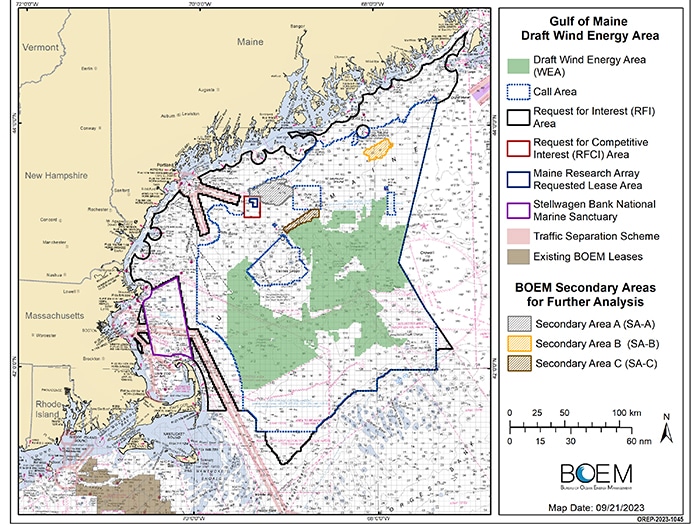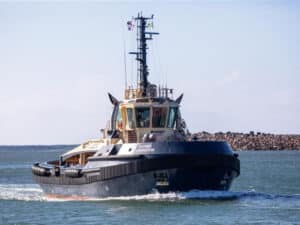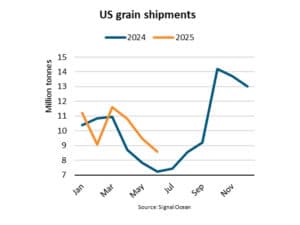
Plans for Gulf of Maine offshore wind advance
Written by Nick Blenkey
Image: BOEM
Moving ahead on plans for offshore wind development in the Gulf of Maine, the Bureau of Ocean Energy Management (BOEM) yesterday identified a Draft Wind Energy Area (WEA) there, opening a 30-day public review and comment period.
The draft WEA covers approximately 3,519,067 acres offshore Maine, Massachusetts and New Hampshire, ranging from approximately 23 to 120 miles off the coast.
While BOEM sees the Gulf of Maine as having significant opportunities for offshore wind energy development, the deep waters within the Gulf of Maine will require the use of floating offshore wind technologies. With no long-proven international solution that can just be pasted in, this presents challenges that will likely be reflected in lower bids at any lease auction. But it also opens the door for new American technology to be adopted.
BOEM notes that, since the start of the Biden administration, it has approved America’s first four commercial scale offshore wind projects, held four offshore wind lease auctions, initiated environmental review of 10 offshore wind projects, and advanced the process to explore additional Wind Energy Areas in Oregon, Gulf of Maine and Central Atlantic. The department says it has also taken steps to evolve its approach to offshore wind to drive towards union-built projects and a domestic based supply chain.
The draft WEA announced yesterday has a capacity of over 40 GW, which exceeds the current combined offshore wind energy planning goals for the Gulf of Maine states: 10 GW for Massachusetts and 3 GW for Maine. Future adjustments to the Draft WEA will likely be made after incorporating feedback during the comment period, while striving to retain sufficient area to meet the Gulf of Maine states’ planning goals.
To identify the draft WEA, BOEM worked collaboratively with the National Oceanic and Atmospheric Administration’s National Centers for Coastal Ocean Science to develop an ocean planning model that identifies and minimizes conflicts with coastal and marine resources and ocean users. BOEM also met with and incorporated feedback from tribes, fishing interests, and the public to refine the model and inform the potential offshore locations that appear most suitable for floating offshore wind energy development.
The draft WEA avoids Lobster Management Area 1 and all North Atlantic Right Whale Restricted Areas. The draft WEA also avoids other important fishing areas and habitats, including important groundfish areas east of the Western Gulf of Maine Closure and within the 10-kilometer buffer from Georges Bank, Platts Bank, Parker Ridge, and Three Dory Ridge. In response to initial conversations with tribal nations located within Maine, the Draft WEA strives to avoid a majority of the historic and present fishing grounds of those tribes. BOEM says it will continue to consult with all tribal nations and other stakeholders who have an interest in the region to understand their concerns with potential offshore wind energy development and minimize conflicts.
BOEM also seeks comments on whether to add all or parts of three secondary areas that were identified for additional analysis but not part of the draft WEA.
BUSINESS NETWORK WELCOMES MOVE
“We welcome today’s advancement of draft offshore wind areas in the Gulf of Maine and the continued progress of this administration to hold seven auctions before 2025,” said John Begala, vice president of federal and state policy at the Business Network for Offshore Wind. “This commitment to create a pipeline of future auctions has brought increased confidence to the U.S. market, resulting in billions in new supply chain and infrastructure investments. Advancing leasing in the Gulf of Maine sustains that confidence and unlocks new investment in the U.S. floating offshore wind supply chain, giving our nation the opportunity to catch up with the global market in this emerging field. Floating offshore wind is also crucial to New England states, whose demand for new, clean power generation is predicted to grow from current levels as they move to decarbonize their economies.”
- More at BOEM’s Gulf of Maine Activities page




